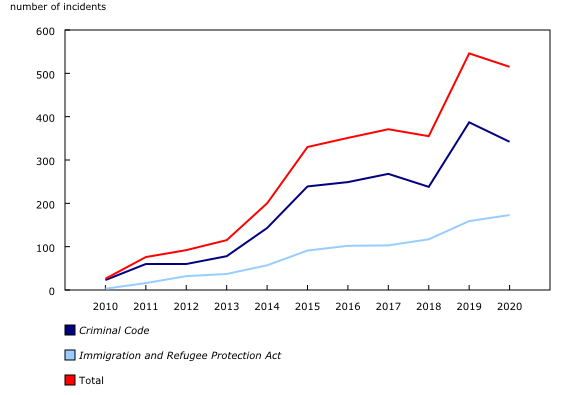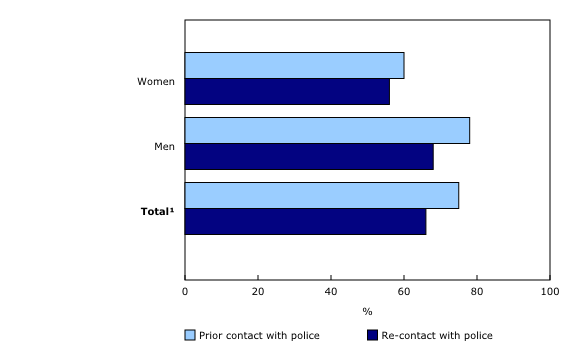Trafficking in persons in Canada, 2020
Released: 2022-06-09
From 2010 to 2020, there were nearly 3,000 incidents of human trafficking reported by Canadian police services, almost all of which involved young women and girls as victims. Where an accused person was identified, 8 in 10 were men and three-quarters of accused were previously known to police.
Trafficking in persons, better known as human trafficking, involves the recruitment, transportation, holding, concealing and exercising control over a person for the purposes of exploitation. Human trafficking differs from human smuggling in two ways. First, human trafficking can occur both within and outside a country's borders, whereas human smuggling requires an international border crossing. Second, those who are smuggled are free once they arrive at their destinations, whereas those who are trafficked are subjected to coercive practices and exploited for sex or labour, or both.
The Juristat article, "Trafficking in persons in Canada, 2020," released today, uses police-reported and court data to provide an overview of trends in human trafficking incidents, prior police contact among accused persons and the outcomes of cases that go through the court system. In addition, the infographic "Police-reported human trafficking in Canada, 2010-2020" presents some recent trends in police-reported data on human trafficking.
Official statistics, while important, provide only a partial picture of human trafficking in Canada due to its underground and underreported nature. Identifying incidents of human trafficking depends in part on police resources and expertise, as well as victims' ability to recognize and to report their victimization.
Police-reported human trafficking declines slightly in 2020
Following a notable jump in police-reported human trafficking incidents in 2019, the number was slightly lower in 2020, decreasing from 546 to 515 incidents. The number of human trafficking incidents in 2020, however, exceeded annual counts documented from 2010 to 2018, a period when the number of incidents generally rose. The decline in 2020 may be the result of the unique and challenging circumstances brought about by the restrictions associated with the COVID-19 pandemic, which could have decreased the opportunities for this type of crime to occur while increasing the likelihood for it to go undetected. Despite the tightening of border crossings due to the COVID-19 pandemic, there was a slight increase in the number of human trafficking incidents related to the Immigration and Refugee Protection Act, with 173 incidents reported by police in 2020 compared with 159 in 2019.
Since 2010, the highest average annual rates of human trafficking in the provinces were generally documented in Nova Scotia and Ontario, findings that remained true in 2020. Specifically, Nova Scotia reported 6.2 incidents and Ontario 2.3 incidents per 100,000 population in 2020, both well above the national average (1.4 incidents). While the figures documented in Ontario may be expected considering it is Canada's most populous province and home to the busiest international border crossings, the rate of human trafficking in Nova Scotia is better explained by geographic location. Nova Scotia in general, and Halifax in particular, has been identified as a trafficking hub frequently used to move victims from Atlantic Canada to the rest of Canada.
Similarly, since 2010, the large majority (86%) of human trafficking incidents have been reported by police services in census metropolitan areas, and this continued to be the case in 2020 (82%). Police-reported data, however, do not capture victim mobility: that is, victims may have lived in another part of the country and were trafficked to large urban cities.
Most detected victims of human trafficking are young women and girls
From 2010 to 2020, women and girls represented the vast majority (96%) of detected victims of human trafficking, and 25% of all victims were under the age of 18. Conversely, the large majority (79%) of persons accused of human trafficking were men.
Just over 9 in 10 (91%) victims knew those accused of trafficking them. Most commonly, victims were trafficked by an intimate partner (31%) or a casual acquaintance or friend (31%). A tactic employed by some traffickers involves drawing a potential victim into a romantic relationship with promises of love and affection, with the end goal of exploitation.
An accused person is identified in just under half of human trafficking incidents
Of all incidents of human trafficking reported by police from 2010 to 2020, just under half (48%) were cleared (meaning an accused person was identified by police). Charges were laid or recommended for the vast majority (91%) of these accused.
More than half (57%) of human trafficking incidents involved human trafficking offences alone, while 43% involved at least one other type of violation, most often related to the sex trade.
Three-quarters of persons accused of human trafficking have prior contact with police
Three-quarters (75%) of persons accused of human trafficking had a prior contact with police before their initial human trafficking contact, and two-thirds (66%) had another contact with police (i.e., a re-contact) afterwards. These are not mutually exclusive as some accused persons may have had contact with police both before and after the human trafficking incident.
Among those who had been accused of a crime prior to human trafficking, their crimes varied and included both violent and non-violent crimes. Just over 9 in 10 (91%) were implicated in non-violent incidents, which most commonly involved property crimes and offences under the Controlled Drugs and Substances Act. Meanwhile, just over 7 in 10 (71%) had been accused of violent crimes, which most commonly involved physical assault-related offences.
Following their first human trafficking contact with police, just over 1 in 10 (11%) were accused of human trafficking again during the reference period (2009 to 2020).
Small proportion of human trafficking court cases result in a guilty finding, but when they do, a sentence of custody is common
Similar to the upward trend in the number of police-reported incidents, the number of human trafficking cases and charges going through the court system has also grown. From 2009/2010 to 2019/2020, the number of human trafficking charges and cases completed in adult criminal courts in Canada generally increased year over year, albeit with some fluctuations. In 2019/2020, 128 human trafficking cases and 396 charges were completed, approximately 10 times as many cases and almost 17 times as many charges compared with 2009/2010 (where 13 cases and 24 charges were completed).
As the most serious decision in adult criminal court, a finding of guilt was less common for cases involving human trafficking charges (12%), than for those involving sex trade charges (33%) or violent charges (48%). Human trafficking cases, however, took twice as long to process through courts than violent offence cases (a median of 373 days versus 176 days). That said, when cases of human trafficking resulted in a finding of guilt, the most common sentencing outcome was custody (86%).
Note to readers
Police-reported data come from the Uniform Crime Reporting Survey, and the category of human trafficking offences includes six offences under the Criminal Code and one offence under the Immigration and Refugee Protection Act that targets international cross-border trafficking. Police services can report up to four violations for each criminal incident.
- Criminal Code offences: trafficking in persons; trafficking in persons under 18 years; material benefit from trafficking in persons; material benefit from trafficking of persons under 18 years; withholding or destroying documents; and withholding or destroying documents to facilitate trafficking of persons under 18 years.
- Immigrant and Refugee Protection Act: trafficking in persons into Canada.
In order to explore prior contacts and repeated contacts (i.e., re-contacts) with police among those accused of human trafficking, a deterministic record linkage was completed. The linkage is based on police-reported data on human trafficking accused persons and incidents from 2009 to 2020, from the Uniform Crime Reporting Survey, Trend Database. All accused persons (i.e., not companies) were considered in-scope if they linked to a police-reported incident during the reference period. From there, those who were accused of human trafficking—either under the Criminal Code or the Immigration and Refugee Protection Act—were linked back to all police-reported incidents.
Data on human trafficking in courts come from the Integrated Criminal Court Survey which collects statistical information on adult criminal and youth court cases involving Criminal Code and other federal statute offences. A case is defined as one or more charges against an accused person or company that were processed by the courts at the same time and received a final decision. A case combines all charges against the same person having one or more key overlapping dates (date of offence, date of initiation, date of first appearance, date of decision, or date of sentencing) into a single case. Guilty findings include guilty of the charged offence, of an included offence, of an attempt of the charged offence, or of an attempt of an included offence. This category also includes guilty pleas, and cases where an absolute or conditional discharge has been imposed.
Products
The article "Trafficking in persons in Canada, 2020" is now available as part of the publication Juristat (85-002-X). The infographic "Police-reported human trafficking in Canada, 2010-2020" (11-627-M) is also released today.
Contact information
For more information, or to enquire about the concepts, methods or data quality of this release, contact us (toll-free 1-800-263-1136; 514-283-8300; infostats@statcan.gc.ca) or Media Relations (statcan.mediahotline-ligneinfomedias.statcan@statcan.gc.ca).
- Date modified:


